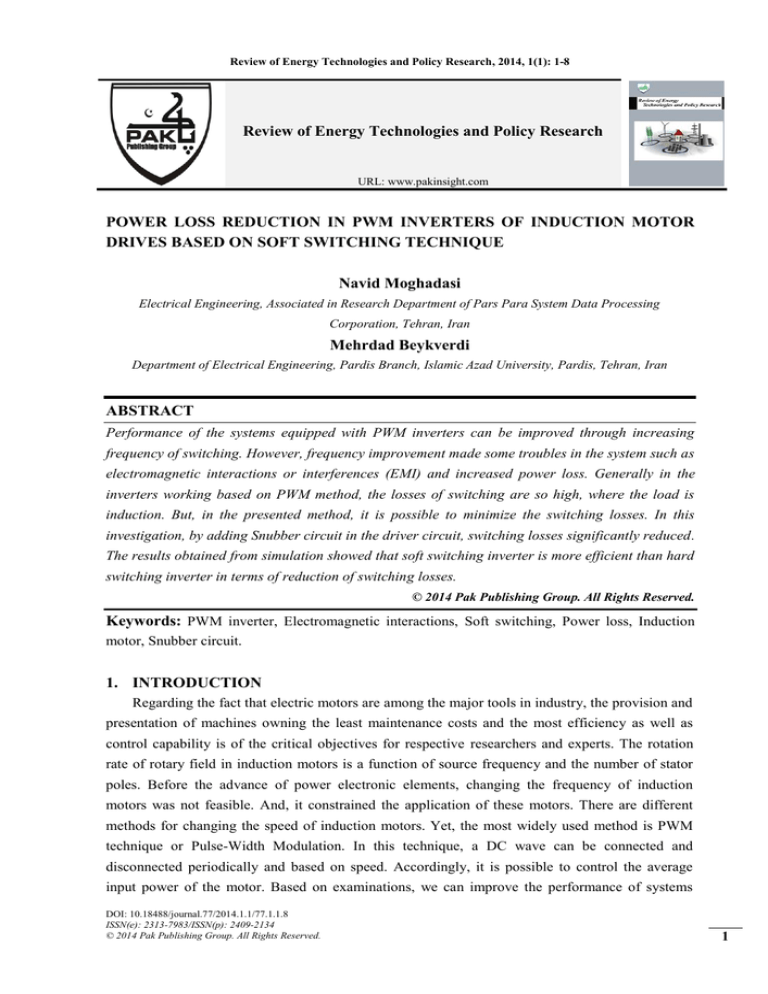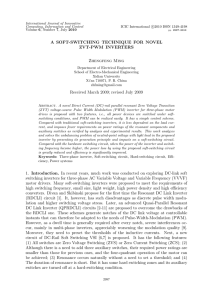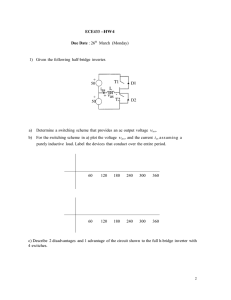
Review of Energy Technologies and Policy Research, 2014, 1(1): 1-8
Review of Energy Technologies and Policy Research
URL: www.pakinsight.com
POWER LOSS REDUCTION IN PWM INVERTERS OF INDUCTION MOTOR
DRIVES BASED ON SOFT SWITCHING TECHNIQUE
Navid Moghadasi
Electrical Engineering, Associated in Research Department of Pars Para System Data Processing
Corporation, Tehran, Iran
Mehrdad Beykverdi
Department of Electrical Engineering, Pardis Branch, Islamic Azad University, Pardis, Tehran, Iran
ABSTRACT
Performance of the systems equipped with PWM inverters can be improved through increasing
frequency of switching. However, frequency improvement made some troubles in the system such as
electromagnetic interactions or interferences (EMI) and increased power loss. Generally in the
inverters working based on PWM method, the losses of switching are so high, where the load is
induction. But, in the presented method, it is possible to minimize the switching losses. In this
investigation, by adding Snubber circuit in the driver circuit, switching losses significantly reduced.
The results obtained from simulation showed that soft switching inverter is more efficient than hard
switching inverter in terms of reduction of switching losses.
© 2014 Pak Publishing Group. All Rights Reserved.
Keywords: PWM inverter, Electromagnetic interactions, Soft switching, Power loss, Induction
motor, Snubber circuit.
1. INTRODUCTION
Regarding the fact that electric motors are among the major tools in industry, the provision and
presentation of machines owning the least maintenance costs and the most efficiency as well as
control capability is of the critical objectives for respective researchers and experts. The rotation
rate of rotary field in induction motors is a function of source frequency and the number of stator
poles. Before the advance of power electronic elements, changing the frequency of induction
motors was not feasible. And, it constrained the application of these motors. There are different
methods for changing the speed of induction motors. Yet, the most widely used method is PWM
technique or Pulse-Width Modulation. In this technique, a DC wave can be connected and
disconnected periodically and based on speed. Accordingly, it is possible to control the average
input power of the motor. Based on examinations, we can improve the performance of systems
DOI: 10.18488/journal.77/2014.1.1/77.1.1.8
ISSN(e): 2313-7983/ISSN(p): 2409-2134
© 2014 Pak Publishing Group. All Rights Reserved.
1
Review of Energy Technologies and Policy Research, 2014, 1(1): 1-8
using PWM inverters. Using the topologies of inverters by hard switching technique resulted in
considerable switching losses, electromagnetic interference, and the reduction of the inverter
efficiency. The type of switching in which the voltage of feeding source is completely placed on
transistors and resistors when each phase switch is called hard switching. In this method,
considerable losses occur on switches which are highly effective in reducing the efficiency of
inverter. If switching is done when we have zero voltage or current, then the losses on switches will
be removed. This type of switching is defined as soft switching. In these inverters, using other
elements leads to resonance at the time switching circuit and reduces current to zero. This
frequency increase can result in the increase of switching losses [1-3].
The idea of using ZVS and ZCS modes in three-phase inverters is done via Spatial Vector
Modulation or Pulse-Width Modulation (PWM). That is, a small time is allocated to direct the
secondary switches in the interval of turning on and off the two main switches of the inverter. The
secondary switches are turned on so that circuit works in resonance state in a fraction of the main
period. Then, Zero Voltage Switching (ZVS) when switching on and Zero Current Switching
(ZCS) when switching off will be possible for the main switches. In the inverters working by PWM
method, the losses of switching the switches are high since the load is induction. But, in the
presented method, it is possible to minimize the switching losses. In this paper, it is demonstrated
that as Snubber circuit is added, we can significantly reduce switching losses [4].
2. SIMULATION METHOD
To simplify the analysis of this perspective, the following assumptions are assumed:
The entrance filter capacitor (Ci) is big enough. Then, dc voltage (Vd) is presumed constant. All
resonance inductor and capacitors are together where Cr is the amount of stray capacitance, IGBT,
and the external capacitance added. And, Lr is significantly smaller than the inductance of motor.
Hence, load current can be considered as the short length of stator switching. The schematic view
of the inverter is shown in Figure 1 with respect to the secondary switches.
Figure-1. The schematic view of soft switching inverter using Snubber
© 2014 Pak Publishing Group. All Rights Reserved.
2
Review of Energy Technologies and Policy Research, 2014, 1(1): 1-8
One of the methods for reducing extra voltage in the switch is to use Snubber networks [5]. A
variety of Snubbers used in the inverters include RC, RL and (or) RCD Snubber. RC and RCD
Snubbers lead to the reduction of switching losses and decrease of voltage changes rate when
transistors are off. This can be used in this simulation. In Figure 2, Snubber network and the way it
is connected to respective circuit are illustrated [6, 7].
Figure-2. Snubber network and the way it is connected to respective circuit
3. MEASURING AND CALCULATING SWITCHING LOSSES
Losses in power inverters usually consist of two parts: Conduction Losses and Switching
Losses. To estimate the former, the instantaneous power lost at each switch is calculated based on
its instantaneous voltage and current. And, finally, the average value of the instantaneous power is
estimated. The voltage and current of power switches depend on the voltage-current characteristic
of the switch. The accurate calculation of semi-conductor losses is required for designing a reliable
system which uses the smallest power switches possible. In case of using PWM switching pattern
for controlling inverter, power switches are usually switched on and off by high frequency. The
currents of diode and transistors are highly complex. Power losses in the inverters can be calculated
by the direct analysis of the shape of current waves of switches, computer modeling, mathematical
calculations, and so on. Different methods are also presented for this which is generally based on
the mathematical analysis of the wave shape of current in power switches [8].
Using mathematical equations to calculate the losses usually accompany approximations.
Accordingly, it is possible to sample the voltage and current and calculate instantaneous power
using P=VI. Average power is also determined by integrating the above equation. For instance, in
some calculations, it is assumed that the load current is completely a sine current. And, its
harmonics are ignored. Besides, due to the complexity of the actual model of power switches,
© 2014 Pak Publishing Group. All Rights Reserved.
3
Review of Energy Technologies and Policy Research, 2014, 1(1): 1-8
models are replaced with completely approximate models in most of the switches calculations. As a
result, there is partially significant difference between the calculated values and the actual values.
In case of computer modeling of power inverters, a relatively accurate model of power switches
can be applied.
Several methods are presented for the computer modeling of inverters. It is really a boring and
time-consuming work to calculate the equations of power inverters state for each certain topology.
As a result, it is not possible to directly simulate the state equations of these models using
calculation software like MATLAB [9].
Switching Function can be used as the powerful tool of analyzing power models. In this
method, power inverters are modeled based on their output wave rather than their circuit topology.
It was possible to define the actual characteristics of each certain switch, in this method. And, it is
no longer required to calculate the system state equations for its simulation. Due to the simplicity
of the model applied, the issue of conversion is resolved and the times required for simulation is
effectively reduced. Another property of the method is that it is possible to generalize it to other
power inverters [10, 11].
4. VOLTAGE AND CURRENT WAVEFORM BEFORE AND AFTER ADDING
SNUBBER
To observe the effect of adding Snubber in the circuit, we assume that the secondary switches
include a leakage induction. Then, we will see that the switching losses of switches will
considerably increase. In fact, the higher losses occur at the time of start-up. To show the effect of
adding the Snubber circuit which prevents from the instantaneous changes of switch voltage, the
shape of voltage and current waves of the secondary switch is presented in Figures 3 and 4 after
and before adding Snubber.
Figure-3. The shape of voltage and current waves of the secondary switch before adding Snubber
© 2014 Pak Publishing Group. All Rights Reserved.
4
Review of Energy Technologies and Policy Research, 2014, 1(1): 1-8
Figure-4. The shape of voltage and current waves of the secondary switch after adding Snubber
In this figure, smaller changes in the secondary switch voltage after adding Snubber can be
clearly seen. With respect to the reduction of voltage frequencies and the direct relationship
between the losses and voltage-current product, it is shown that Snubber circuit results in the
decrease of switch losses. To prove the reduction of the main switches losses as the secondary
switches are added, the shape of voltage and current waves at the both ends of the main switch in
two types of hard and soft switching (before and after adding secondary switches) are represented
in Figures 5 and 6.
Figure-5. The shape of voltage and current waves of the main switch after adding Snubber
© 2014 Pak Publishing Group. All Rights Reserved.
5
Review of Energy Technologies and Policy Research, 2014, 1(1): 1-8
Figure-6. The shape of voltage and current waves of the secondary switch after adding Snubber
It is seen that high peak values of voltage and current lead to the considerable increase of
instantaneous power. The average values of losses before and after adding switch are measured
then and the shape of their waves are shown. In this simulation, measuring average power is first
sampled from the switch voltage and current. Then, it enters into a multiplier or analogue and its
average is measured. As seen in the following figures, the average switching losses of switch
connection and disconnection percentage has reached a stable value. As observed, the value is more
compared to the time when we did not use Snubber. Hence, using Snubber has resulted in the
reduction of the secondary switches losses in the start-up moment. Selecting Snubber elements is
done with respect to the value of switching frequency and the maximum current of each switch as
well as the leakage induction.
5. COMPARING SWITCHING IN PWM INVERTER CIRCUIT EQUIPPED
SNUBBER
In this simulation, a diode-resistor-capacitor Snubber (10Ω and 1nF) and a high frequency
diode were used. In Figure 7, resistor and capacitor R6-C4 was applied to calculate average
instantaneous power measured. Simulating inverter circuit losses without using Snubber is
illustrated in Figure 8.
Figure-7. Resistor and capacitor for measuring average power
© 2014 Pak Publishing Group. All Rights Reserved.
6
Review of Energy Technologies and Policy Research, 2014, 1(1): 1-8
Figure-8. The switching losses of the inverter without using Snubber
Figure-9. Switching losses in inverter using Snubber
In Figure 9, the simulation of soft switching inverter using Snubber is illustrated in terms of
switching losses. The comparison between Figures 8 and 9 demonstrates that the switching losses
in the inverter are reduced using secondary switch and Snubber.
6. CONCLUSION
In comparison with hard switching technique, the soft switching technique of PWM inverter
leads to the reduction of switching losses. Yet, the switching losses are again considerable.
However, they can be decreased using Snubber circuit. The soft switching of PWM inverter was
compared together with Snubber circuit. Regarding the results of the presented simulation, it was
demonstrated that soft switching inverter using Snubber circuit has better potential for reducing
switching losses compared to soft switching inverter.
© 2014 Pak Publishing Group. All Rights Reserved.
7
Review of Energy Technologies and Policy Research, 2014, 1(1): 1-8
REFERENCES
[1]
E. Abdolreza and T. Fazel, "Suppressing of common-mode voltage, shaft voltage, leakage current
and EMI generated by voltage source PWM inverter," International Electrical Engineering Journal
(IEEJ), vol. 1, pp. 529-535, 2011.
[2]
H. Yamamoto, M. Kaneda, and N. Mutsuo, "Three-phase soft-switching inverter resonant with
unique resonant snubbers, power electronics and drive systems, PEDS '99," in Proceedings of the
IEEE 1999 International Conference, pp. 1078 –1083, 1999.
[3]
K. H. Chao and C. M. Liaw, "Three-phase soft-switching inverter for induction motor drives," IEE
Prc. Electric Power Application, vol. 148, pp. 8-20, 2001.
[4]
M. A. Jabbar and M. A. Rahaman, "Radio frequency interference ofelectric motor and associated
controls," IEEE Tram. On Ind. Appl., vol. 27, pp. 27-31, 1991.
[5]
K. Lee-Hun, Y. Hwan-Kyun, W. Chung-Yuen, K. Young-Real, and C. Gi-Su, "Output filter design
for conducted EMI reduction of PWM inverter-fed induction motor system," presented at the In
Proc. IEEE PEDS’01, 2001.
[6]
K. Lee-Hun, K. Jun-Ho, H. Nyon-Kun, W. Chung-Yuen, and K. Young-Real, "A novel PWM
switching technique for conducted EMI reduction in field-oriented control of an induction motor
drive system, Industrial electronics society, 2005," presented at the IECON. 31st Annual Conference
of IEEE, 2005.
[7]
L. Qin, C. Dong, and Z. P. Fang, "Novel loss and harmonic minimized vector modulation for a
curent-fed quasi-z-source inverter in HEV motor drive application," IEEE Transaction on Power
Electronics, vol. 29, pp. 1344- 1354, 2014.
[8]
B. York, Y. Wengsung, and L. Jih-Sheng, "Hybrid-frequency modulation for PWM-integrated
resonant converters," IEEE Transaction on Power Electronics, vol. 28, pp. 985- 994, 2013.
[9]
N. Nho-Van, B.-X. Nguyen, and H. L. Hong, "An optimized discontinuous PWM method to
minimize switching loss for multilevel inverters," IEEE Transaction on Industrial Electronics, vol.
58, pp. 3958- 3966, 2011.
[10]
M. Rezvanyvardom, E. Adib, and H. Farzanehfard, "New interleaved zero-current switching pulse
width modulation boost converter with one auxiliary swith," IET Power Electronics, vol. 4, pp. 979983, 2011.
[11]
M. Xiaolin, R. Ayyanar, and H. K. Krishnamurthy, "Optimal variable switching frequency scheme
for reducing switching loss in single-phase inverters based on time-domain ripple Analysis," IEEE
Transaction on Power Electronics, vol. 24, pp. 991- 1001, 2009.
Views and opinions expressed in this article are the views and opinions of the authors, Review of Energy Technologies
and Policy Research shall not be responsible or answerable for any loss, damage or liability etc. caused in relation
to/arising out of the use of the content.
© 2014 Pak Publishing Group. All Rights Reserved.
8




